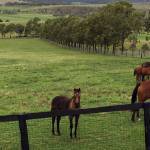Grazing Kikuyu Grass: Look Out for Your Horse’s Bones

Horses are designed to process large volumes of forage efficiently, and high-quality pasture should be the primary component in the diets of most horses. In some subtropical areas of Australia, New Zealand, South America, and South Africa that pasture may be kikuyu grass. In the United States, it is interesting to note that kikuyu is sometimes listed as a noxious grass. While kikuyu can be used for grazing by horses, the grass comes with both advantages and disadvantages.
On the plus side, kikuyu is a productive and persistent warm-season grass that provides exceptional ground cover, tolerates heat, and responds quickly to rain. It also copes well with heavy traffic. Unlike cool-season grasses, kikuyu doesn’t contain fructans, indigestible sugars that can lead to hindgut disturbances or trigger laminitis.
Early-growth kikuyu has high protein, sugar, and energy content so horses do well on it, but they can become overweight easily. If your horse is prone to obesity and equine metabolic syndrome with risks of concomitant laminitis, beware of early-spring kikuyu pastures. Behavior problems may also arise from energy overload. Reduced time in the paddock or a grazing muzzle may be required for horses sensitive to kikuyu.
Despite its advantages, kikuyu has a few downsides. Kikuyu tends to dominate other grasses, dries off in winter, and is less digestible than cool-season grasses. Because of the decreased digestibility, weanlings don’t do quite as well on kikuyu and can become potbellied when grazing it.
A key problem with kikuyu relates to calcium and skeletal health. Kikuyu is lower in calcium and higher in phosphorus than other grasses, which contributes to body-wide mineral imbalance. The grass also contains oxalate chemicals that bind calcium in the gut, which dramatically reduces calcium digestibility. Both of these factors lead to calcium being pulled from the skeleton to maintain adequate blood levels. As more calcium is removed from bones, they become weaker, which can cause reduced bone density with shifting lameness or fractures and big head disease characterized by enlargement of the upper jawbone.
Supplementing calcium and other minerals is vital in preventing big head disease in horses grazing lush kikuyu paddocks with large grass intakes. Adding lucerne hay to the diet will help as it has high calcium content. However, a feed or supplement with high levels of calcium, other trace minerals, and vitamins is typically necessary for these horses. If horses don’t need extra energy, a ration balancer is an appropriate feedstuff due to its low feeding rates and concentrated nutrients.
In choosing a supplement, Triacton is a highly digestible source of calcium and contains other trace minerals and vitamins. Because of its research-proven ability to increase bone density, Triacton would be an appropriate supplement, especially for horses already suffering the effects of big head disease.
Bone Food Plus is formulated to supply vital bone-building nutrients and supplies the essential building blocks to support bone health in horses grazing high-oxalate pastures such as kikuyu.








